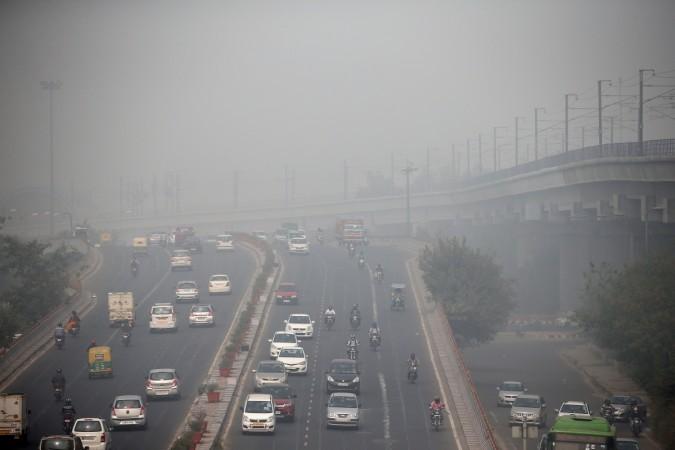
Air pollution has assumed great significance in India recently. The quality of air in North India during Diwali this year was one of the world's worst and New Delhi was declared the most polluted city on Earth in the first week of November. In a chat with International Business Times India (IBT), Vibhor Jain, CEO of Atlanta Healthcare, talks about air pollution in India and safety measures.
IBT: Air pollution has assumed great significance in India recently. What factors are increasing it?
The drastic increase in air pollution levels across India over the years can be vastly attributed to increase in industrial chimney waste, thermal power stations, burning of farms and vehicular emission etc. However, the effect of air pollution is completely different in the northern parts of India as compared to the rest of the country. In the coastal regions of India, the air quality might not be very poor as the wind speed and climatic conditions lead to easy dispersion of air pollutants. Comparatively, in the Northern plains, the air quality worsens much faster due to low wind speed. While climatic conditions are only minor culprits for bad air quality, man-made pollution sources act as a huge contributor across the country.
Burning of stubble in paddy fields, emissions from vehicles, industries using coal, loose dust from construction sites as well as road pavements, and burning of trash containing plastic, rubber and metal items are the major culprits contributing to air pollution in India. In fact, by 2013 air pollution was recognized as the fifth largest killer in India.
IBT: What can we do to decrease air pollution as individuals?
When we talk about reducing air pollution, from an individual standpoint there are long-term measures coupled with short-term solutions, and it is necessary that we adapt both.
Long-term measures involve switching to green fuels, using public transport, car-pooling and creating awareness amongst people against the usage of solid fuels for cooking. Planting trees is also an important measure as in the long term it would reduce the amount of loose soil.
From indoor air perspective, one could look at using natural cleaning agents instead of chemical cleaning agents that emit VOCs, creating ample ventilation (especially in the kitchen area), minimize the e of chemical based air fresheners, sprinkle water outside the house in order to keep the dust settled and use wet mops rather than using the broom to clean the house.
These are certainly small contributions but each one them has the potential to decrease air pollution.
IBT: When buying air purifiers what must we keep in mind?
In order to buy the best air purifier, we must have knowledge about the parameters that makes a good air purifier. These parameters can be categorized into two i.e. primary and secondary. The primary parameters are high CADR ratings, purification technology, stages of filtration, grade of filters and cost. The secondary parameters are the features that the air purifier has to offer. An air quality sensor and filter change indicator are two features that are a must in an air purifier. It enables the user to maintain the machine, which in turn provides efficient filtration. Consumers also must look at the warranty period being offered by the company. A good air purifying company would provide at least 1 year of warranty period.

What kind of weather conditions require air purifiers?
Sources of pollution like vehicular emission and industrial chimney waste exist all-round the year. Seasonal factors like crop burning and temperature inversion lead to increased air pollution in winters, resulting in smog (fog + air pollution). Air pollution is persistent throughout the year, but it is clearly visible during winters.
As stated by WHO, indoor air pollution is far more dangerous than outdoor air pollution. You would be surprised to know that indoor air pollution alone killed 1.3 million people in 2010. Even during summers, when the outdoor air might seem clean to the naked eye, indoor air pollution is considerably high and dangerous for all age groups. It is particularly threatening to the vulnerable groups such as children, pregnant women and elders. Therefore, it is necessary to install air purifiers within a household regardless of the weather conditions.
From an institutional perspective, it is wise to get application based air purifiers as they directly increase business outcome. Atlanta Healthcare has helped many institutions with application based solutions to obtain effective results in production. These institutions include labs, hospitals, restaurants, corporate offices and data centres.
IBT: China has a serious air pollution problem. Is India next?
Unfortunately, India has already overtaken China in air pollution. Recent statistics released by the Global Burden of Disease (GBD) shows that on an average 3,283 premature deaths per day have occurred in India in 2015, whereas there were 3,233 deaths in China during the same time.
It is high time we realize that this issue is not going to subside by itself and we need to take certain steps like the China did to deal with air pollution. The authorities in China have taken a target of cutting down air borne particulate matter levels by 25% by the end of 2017, compared with the levels recorded in 2012. One of the actions taken by the government is a ban on vehicles from outside Beijing to enter the city past the sixth ring road unless they have been given permission. They also have plans of ban the use of private cars at certain times of the day. China has also started investing in technologies that could help them cut down on the use of coal as fuel. They also have integrated environmental protection plan into their "Five Year Financial Plan" to regulate industries adding to air pollution. China has also installed air quality monitors at various locations and and informs people about the air quality in order to increase awareness and promote safety measures. They also have an air pollution alarm system where residents are asked to stay indoors when the air quality outdoors is worsening.
I think even we need to take some extreme steps not slowly but immediately. We did not get here in a day and it will take more than a day to get out of this problem. With proper planning and structure for monitoring, controlling and preventing, we can overcome the problem of air pollution in the near future.














